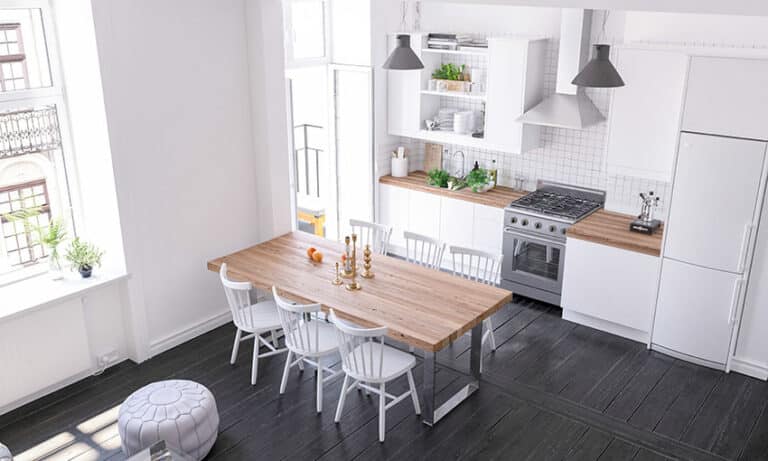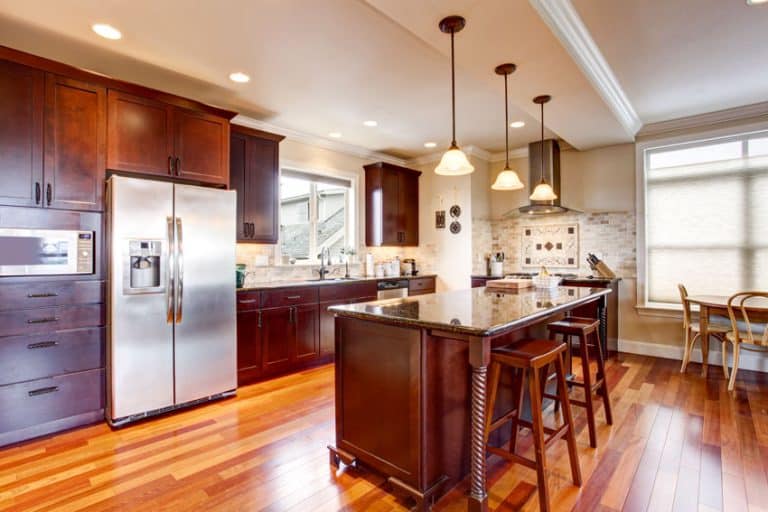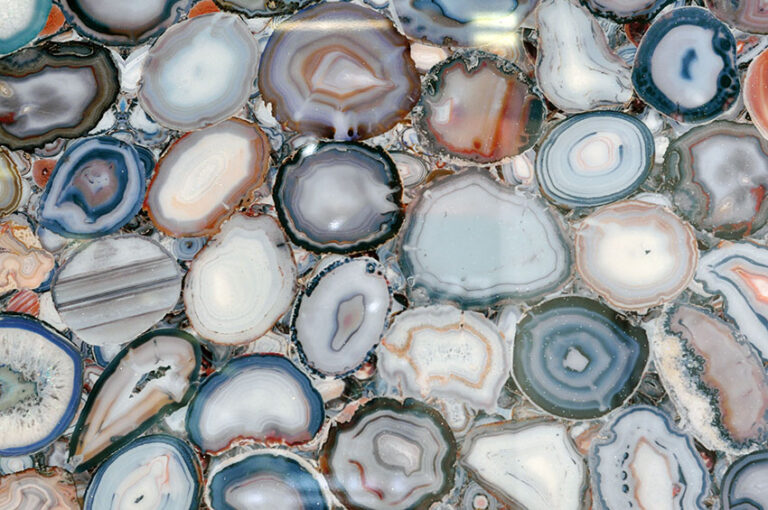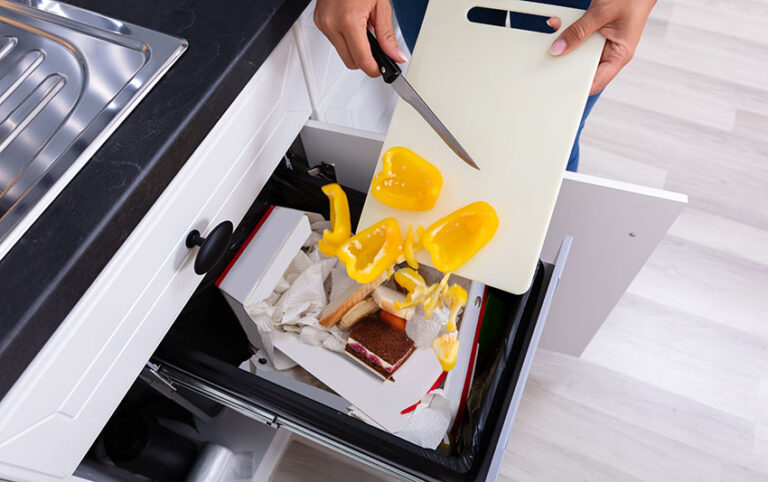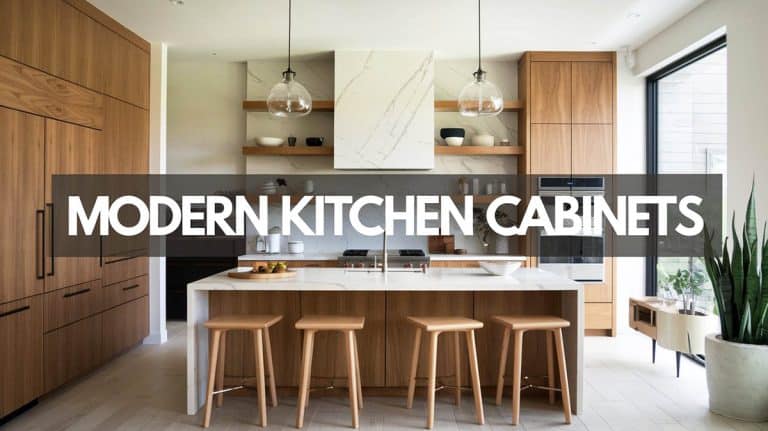Soapstone Backsplash (Kitchen Designs)
When it comes time to choose a material for your backsplash, look no further than soapstone. Soapstone is a popular material for backsplashes in the kitchen or bathroom, thanks to its nonporous, low maintenance requirements, and damage resistance.
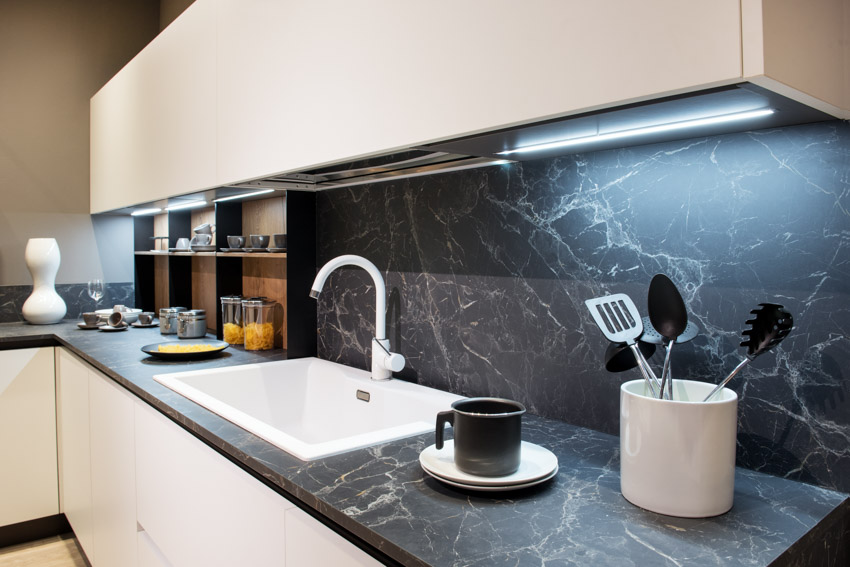
This natural stone is well known for its warmth and softness to the touch, but what makes it so great?
What is a Soapstone?
Soapstone backsplashes are made from quarried metamorphic rock containing significant levels of talc. The amount of talc present in the soapstone dictates how hard it is and consequently whether or not it is suitable for architectural use.
Generally speaking, backsplashes, tiles, and countertops are sourced from soapstone with a talc content of 30% or less.
Soapstone is a popular material for backsplashes thanks to its impermeable qualities that can resist acid and alkaline damage.
This makes it extremely unlikely that you will be able to scar or etch a soapstone backsplash. It is a durable material that’s perfect for installation in high-use spaces like kitchens and bathrooms.
Should damage or discoloration occur on your backsplash, a light sanding with fine-grit sandpaper is all that’s needed to restore a level, evenly colored surface.
Can You Use Soapstone As A Backsplash?
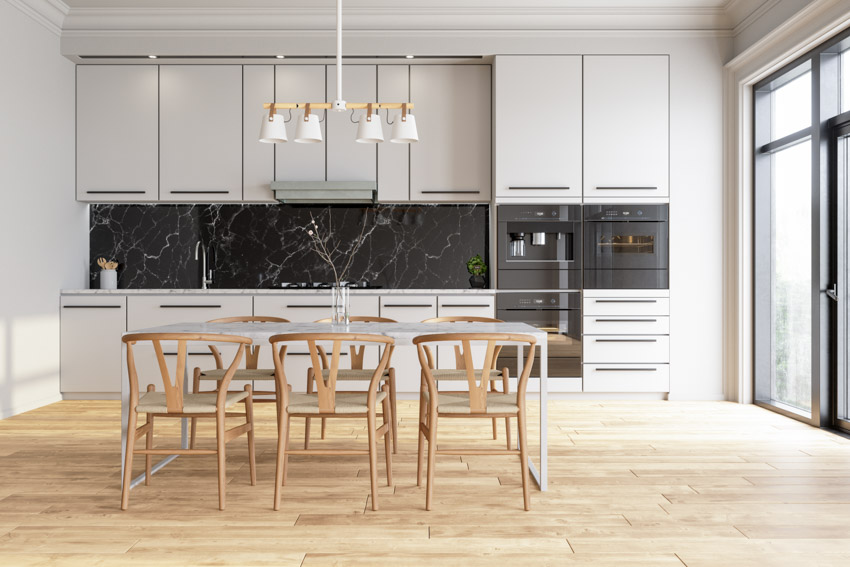
Yes, you can use soapstone as a backsplash. Large, unbroken panels provide a sleek, contemporary element on your kitchen or bathroom wall, protecting the wall and unifying the kitchen design. Soapstone tiles are another attractive and protective option for your backsplash.
Soapstone can be considered one of the best backsplash materials. It can outperform other, more expensive natural stone options such as granite, marble or quartz backsplash.
These backsplashes are easier to repair than natural stone options such as granite. Imperfections or damage to your soapstone backsplash can likely be sanded out, rendering it unnoticeable.
Granite or marble repairs require epoxy or acrylic to even the surface, and it can be quite difficult to match the texture and color of the existing stone.
Another way that soapstone backsplashes outperform marble and granite backsplashes comes down to porosity. Granite and marble are porous stones and must be sealed to prevent penetration by liquids, oils, and bacteria. Soapstone is considered nonporous and will repel stains and spills without the use of sealant.
Soapstone Tile Backsplash
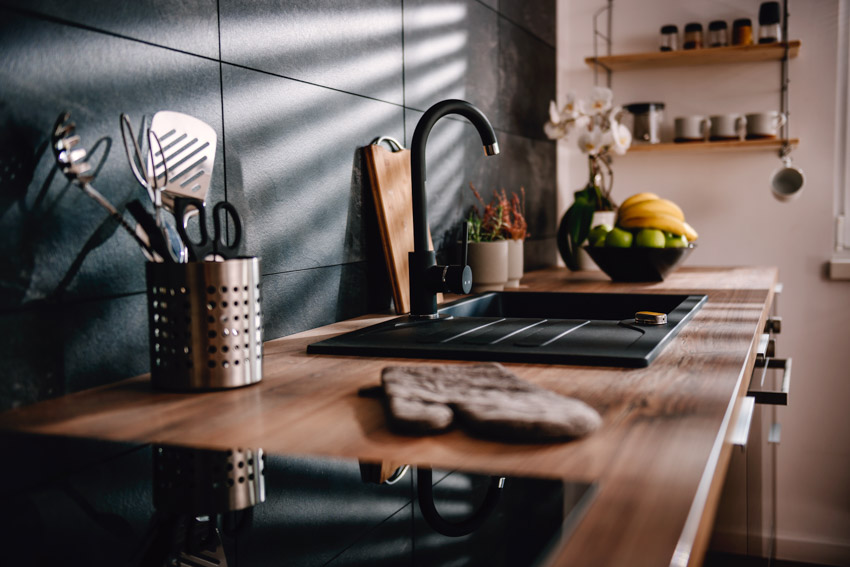
Soapstone is available in large, unbroken panels and can also be cut into tiles. Squares and rectangles are popular, while hexagonal tiles make a bold design statement.
Tiles can be uniform in size and shape, or variations can be used to add texture and heighten visual interest.
As a rule, a backsplash should cover at least the four inches of wall closest to your countertop. You may wish to cover the entirety of the wall behind the range and sink. These tile backsplashes are customizable, attractive, durable, and low maintenance.
Types of Soapstone
Soapstone may not come in a wide range of colors, and it can be difficult to find a particular look. For example, suppose you want the same stone backsplash from a friend’s kitchen. Finding that specific variety can be challenging, as suppliers usually associate names with color variations. The names provided are not consistent, making it difficult to find a specific type.
Instead, look for soapstone that meets your specifications and know the main color variations available. Gray, green, and black. It can also be further categorized as architectural grade and artistic soapstone.
Architectural or Industrial Grade – Has a talc content of 60% to 70% and is primarily used for countertops, backsplashes, fireplace surrounds, and manufacturing of cookware. This type is denser compared to the artistic option and has consistent coloring and texture.
Artistic or Carving Grade – With a talc content of 75%, it is softer than the architectural grade, which makes it easily carved to create sculptures and other types of décor pieces.
Soapstone Remnants – As the term implies, these are cutoffs taken from accidentally broken slabs and thus can no longer be sold in one piece. The lengths can vary from 3 feet to 4 feet, with a minimum of 25 inches in depth. Some suppliers specifically sell discounted remnants.
What Color Does Soapstone Come In?

Soapstone is most often black or gray in color and often has a greenish cast. White veining is common, and elements of brown, green, or blue may also appear on the surface.
The color of soapstone is determined by its mineral content. Slabs that are quarried from the same location at the same time will be similar in color and vein pattern.
With time and exposure to air, the appearance of soapstone will naturally acquire a dark patina. Regular application of mineral oil can be used to speed the darkening process and help ensure that the stone changes color evenly across its surface.
Many consumers find the patina that develops on the surface to be one of its most attractive and desirable qualities. However, other homeowners would prefer to remove this coating. Fine-grit sandpaper can be used to remove oxidized material from the surface of the sandstone and restore its original appearance.
White soapstone exists but is not a suitable material for architectural purposes. The white color comes from a high talc content, which softens the stone considerably and makes it inappropriate for use as a backsplash.
However, some unscrupulous materials suppliers may attempt to get around this fact by advertising white marble as ‘white soapstone’. White marble is not an appropriate substitution, as the two materials differ significantly in porosity and resistance to chemical or acid damage.
Soapstone Color Variations
Green soapstone. Relatively rare, this material can come in a variety of green hues and is sourced mainly in Brazil, Italy, India, Spain, and the United States. The green tones range from lemon green to deep ocean green.
A popular option is the Belvedere Soapstone, which is harder and much more resistant to scratches than other types. A green soapstone backsplash is a perfect cool backdrop to a kitchen countertop and works well with white, black, and gray colors. Other types of green options include Indigo, Santa Rita, Vermont, and Fantasia.
Gray soapstone. A gray soapstone will typically have natural white veining and varying levels of patterns. The top producers of gray options are from India, Canada, Brazil, and the United States.
The Barocca is a gray soapstone variation with a light gray shade and occasional thin white veining. A darker version of gray is the Black Venatta, which has a dark green coloring with long veining and speckled shades. Other types of gray options include Porto Allegre, Python, Tabaka, Mariana, and Alberene.
Black soapstone. With ranging colors from charcoal gray to deep black, a black stone is the perfect contrast for lighter countertops and cabinets. Black soapstone backsplash will have occasional veining and dappled colors.
Amphibole and pyroxene mineral content of this type cause darker discoloration. A popular type of black option is the Venata soapstone due to its white veining, which can create a striking kitchen backsplash with contrasting colors.
Other black variations include Barocca, PA Original, Schist, and Steatite soapstone.
White soapstone. A soapstone dubbed as white in the market may not actually be genuine, but marble, as the mineral does not come in white colors. Any White soapstone will have a white background with dark veining.
Blue Soapstone. Mainly quarried from Brazil, blue soapstone is a type that contains high levels of pyroxene and amphibole, giving it a blue color. It is often used for creating decorative objects and small figurines.
Soapstone Backsplash Ideas
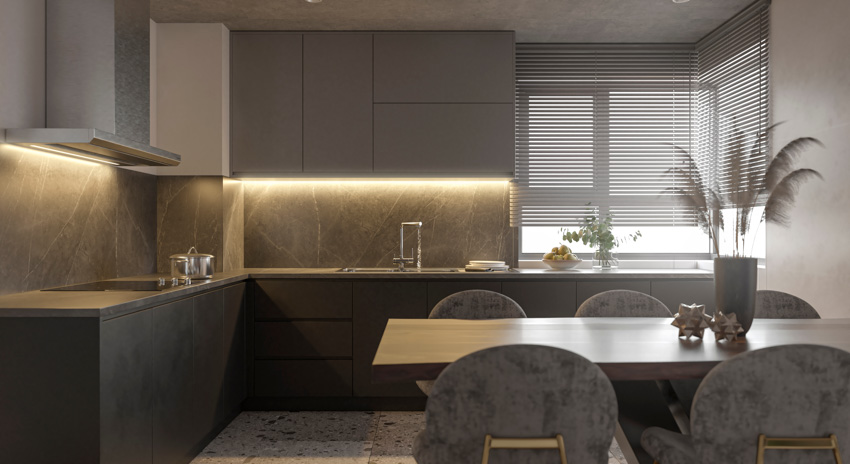
Choose large panels of soapstone for your backsplash to add natural warmth and beauty to your space while protecting your walls. For a lower commitment, consider constructing a partial backsplash from stone panels or tiles and finishing the rest of the backsplash with beadboard.
If you’re completing a historical renovation or attempting farmhouse-inspired decor, this stone backsplash might be just the authentic detail you’ve been looking for.
Consider matching the types of kitchen countertops you use to this kind of backsplash for a pleasing, uniform appearance. Another stone backsplash idea is to match the color of your countertops to the veins in your backsplash, tying the two elements together.
Soapstone Countertops And Backsplash
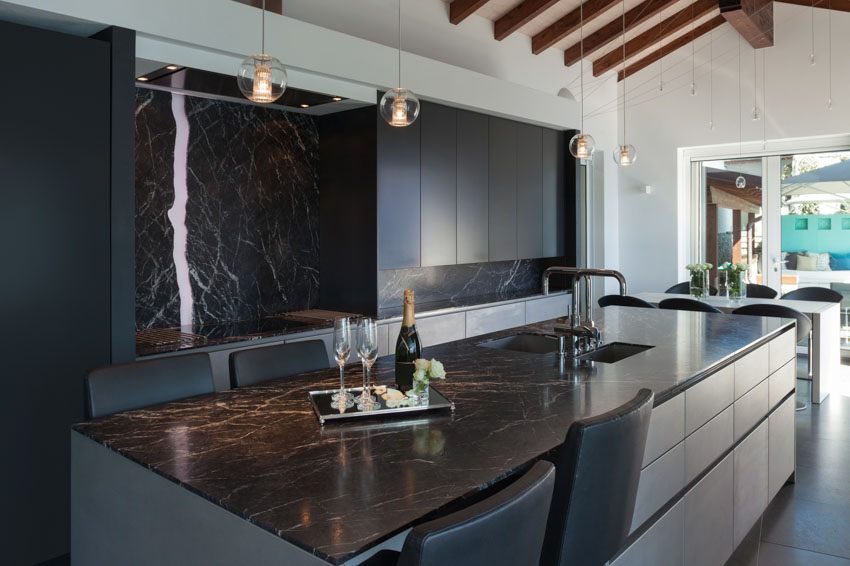
Soapstone isn’t just ideal for backsplashes – it also makes a great countertop material. In fact, all the best qualities of this backsplash are even more useful on the counter surface.
You can place hot pots and pans directly on the surface with no fear of discoloration or scorching. Spills are not a problem with these countertops or backsplashes and can be easily wiped up from this nonporous surface without leaving stains behind. It is also impervious to acid damage from common food and drink items such as coffee, wine, or tomatoes.
Each soapstone slab will vary in appearance depending on the mineral deposit of the stone. You could choose countertops and backsplashes made from the same variety for a unified and cohesive look or add contrast with surfaces in different colors.
Choosing this stone for both your countertops and backsplashes is convenient for care and maintenance, and neither requires sealant.
Strong abrasive cleaning is not recommended for soapstone countertops or backsplashes, as they can scratch the surface. Luckily, vigorous cleaning or abrasive tools are not necessary as these countertops and backsplashes can be cleaned with dish soap and water.
Soapstone Behind Range
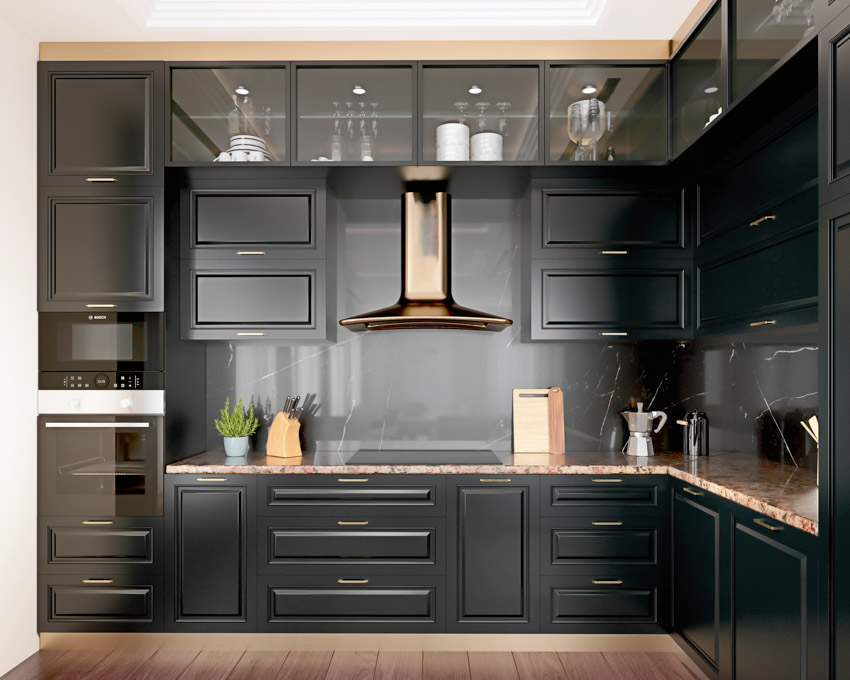
Soapstone is an excellent material to use for the backsplash behind your range, thanks to its high compatibility with heat. These stone backsplashes are very dense and contain large amounts of magnesium. These two qualities are known for allowing its surface to take in and evenly radiate heat without sustaining damage.
Soapstone is so fire-friendly that it’s often used for fireplace construction, masonry-based heating solutions, and cookware.
A material that is tough enough to line the inside of commercial-grade ovens, the stone is more than capable of taking the heat from your range. The backsplash behind your range must withstand high heat, spills, and splashes without taking damage or becoming discolored.
It should be nonporous and easy to clean and maintain. Soapstone is a preferred material for behind-range types of kitchen backsplash because it meets all these criteria. This backsplash behind the range will not become discolored over time.
Since the stone is nonporous, it never needs to be sealed or resealed. For this reason, you can find it used for other areas such as soapstone floor tiles and countertops.
Soapstone Subway Tile Backsplash
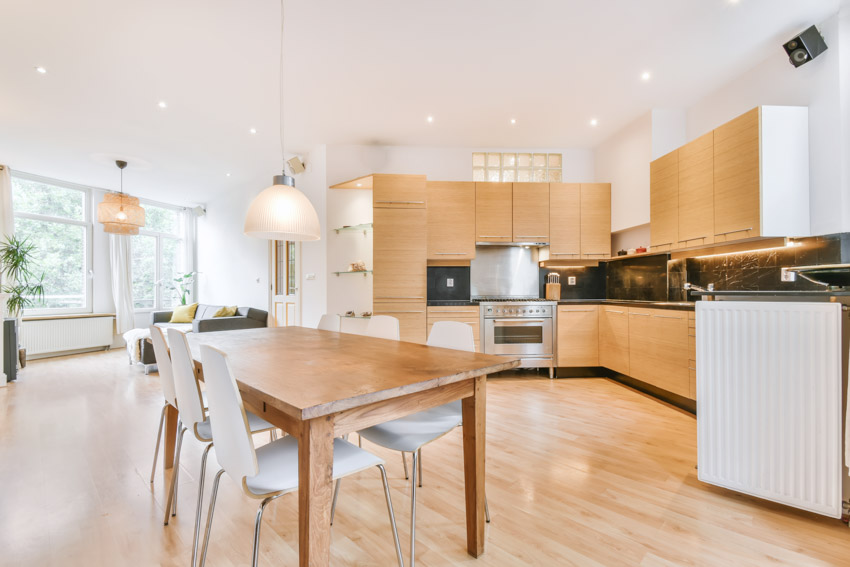
Subway tile backsplashes are a common and popular design choice. When made from soapstone, they provide an attractive, durable barrier that protects the walls behind your countertops.
The standard size for subway tiles is three inches tall by six inches wide. Since the minimum height of a standard backsplash is four inches, a single row of soapstone subway tiles is not sufficient for most kitchen or bathroom needs. Instead, these rectangular tiles are usually laid in a multi-row, horizontal pattern.
In a traditional subway tile layout, each tile straddles the joint of the tiles below (also known as a 50% offset) in a design that resembles brickwork. An emerging trend for subway tiles is to turn them vertically and arrange them in stacks with no offset. Either design is compatible with soapstone.
See more related content in our article about subway tile kitchen backsplash on this page.

